10 most dangerous beaches in the world
 Bashny.Net
Bashny.Net
Beaches and the Tiwi Islands Queensland (Australia): poisonous jellyfish
It is believed that Australian beaches - the most dangerous in the world. In addition to shark attacks, which are common in Australia, almost every year in the resorts of the northern coast, vacationers are victims of jellyfish. They are known to have one of the most potent venoms, and burns caused by their stinging cells can lead to death within minutes. In addition, these jellyfish rather inconspicuous and see them in the water is not easy.
Collision with them most likely in the waters of the Timor and Arafura seas surrounding the islands Tiwi Beach and north-east coast of Queensland. "Sea Wasp" - as they are sometimes called - even become a kind of symbol of the resort: the 2011 edition in Australia, even released a silver coin with the image of the beast.
However, death from encounters with jellyfish still quite rare. The most vulnerable of the victims - the children: they often do not survive his injuries. So, of the 30 reported cases of attacks on the northern coast of Australia over the past 20 years, 12 of them resulted in infant death. However, last year it was miraculously saved 10-year-old girl who was admitted to the hospital with multiple burns.
To reduce the risk, experts advise to refrain from swimming on the northern coast of Australia from October to April, especially in the afternoon when the jellyfish are most active.
Source
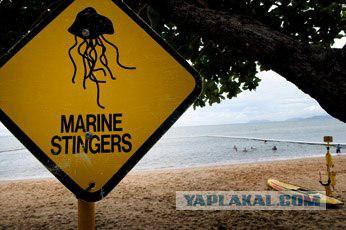
Beaches Fish Hoek (South Africa): white shark
The coast of Cape Town has repeatedly recognized the most dangerous place in the world for tourism in the Atlantic waters surrounding the coast of the province of the Western Cape, home to one of the world's largest populations of white sharks that with the onset of heat are particularly aggressive.
And despite the fact that the majority of the most popular beaches in the South African resort of Fish Hook back in the 1960s were undersea networks, avoid predators attacks still can not. For example, in 2010 there were registered 21 unprovoked shark attack, six of which resulted in death. The last case of shark attack on a person within the coastline was in January of last year and was particularly brutal: the body torn by the police catch the men throughout the following month.
Those who do not want to repeat the fate of the unfortunate can follow the activity of white sharks in the Shark Spotters organization's website in the section «shark activity»: last appearance of white predator there were registered on 21 June.

Zipolite Beach (Mexico): a strong undercurrent
Quiet and small beach with silky white sand and turquoise waters of the Pacific Ocean attracts many tourists. However, the locals prefer to avoid this place - especially during the period from April to June, when the water is here to say, "rebels».
This revolt is expressed strong undercurrents, including the reverse, which is difficult to see from the shore. In addition, in the summer months during the full moon usually occurs ebb and flow of the high seas, with the force of the flow are difficult to handle even an adult. The danger increases and by sea cliffs and rocks that lurk in the depths of the ocean.
Each year, the Mexican authorities to spend a decent amount on the organization of work of the rescuers, and indeed since 2007 on the beach was not a single fatal case (although in 2010 it was officially rescued 180 people who have failed the course, ignoring the set on the shores of the red flags) .
By the way, the name of the beach and the bay - Zipolite - a very disturbing in itself: translated from the local dialect of Zapotec means "Beach of the Dead". Nevertheless, the beach is known as one of the main objectives of the summer nudists and hippies from all over the world: there are inexpensive holiday and picturesque place.
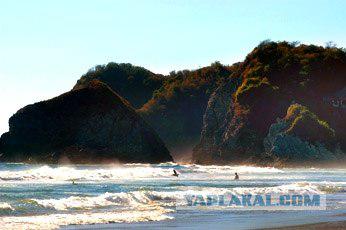
Bikini Atoll (Marshall Islands): high levels of radiation
This small atoll in the Pacific Ocean is famous not only because it gave the name of a bathing suit, a spectacular appearance in which the famous Brigitte Bardot in the film "And God Created Woman." In the period from 1946 to 1958, the first United States used the island for testing atomic and hydrogen bombs in Operation "Crossroads." During the tests, March 1, 1954 the island was destroyed almost completely. Subsequently, more than 800 residents of the Pacific atoll died from various cancers caused by the nuclear tests.
Radiation levels are still above the norm: the average external dose of about 3, 8 R / h. Nevertheless, many believe that some beaches are quite suitable for bikini holiday: tourists from all over the world attracted by the isolation of the "nuclear" of the island. However, to get on the atoll is not so easy, either as part of the Central Pacific Expedition diving, or as tourists on a tour on the official website bikini. Seven-day trips usually take place from mid-April to November, in groups of 12-15 people.
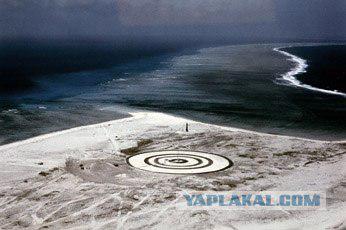
Beach New Smyrna (USA): shark, accidents, lightning strikes
One of the main beaches of Florida rightly gained fame very unhappy resort staff. In 2010, there were recorded 640 collisions various swimming facilities, 68 of which resulted in death - the highest number of accidents on the water ever recorded on the beaches of the US. Experts attribute this to strong overcrowded beach: rescuers and Water Patrol simply no way to keep track of everything.
In addition, New Smyrna is also dangerous because of frequent lightning. Over the past 50 years from a lightning strike killed 459 people here. According to security officials, the people on the beach are the highest points, which means that during thunderstorms priori they become targets for discharges.
In addition to all of the above, and regardless of the weather, holidaymakers on the beach New Smyrna - target sharks. Last summer, 13 people were bitten and, fortunately, only 1 case proved fatal. It is not surprising that the evacuation of people, followed by multi-day closures on this beach - is quite common.
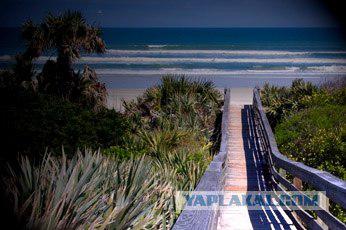
Beach Copacabana (Brazil): a high crime rate
Former mid-1950s playground for recreation of high society, today the Copacabana Beach in Rio de Janeiro has a reputation as the most troubled places to relax: the crime rate there - one of the highest in the whole of Brazil. Robbery, prostitution, drug trafficking, rape and even kidnapping - everyday phenomenon for this place. In 2010, victims of crimes of varying severity it began more than 80 people, while 30 people were killed.
For the Government of Brazil, the region - one of the most problematic: it is in the region of Copacabana, according to police, the largest number of drug lords and members of the mafia. Vacationers also say that danger awaits travelers not only on the Copacabana beach, but also in hotels on the coast, too, is not always easy. And for those who decide to take, for example, rent a yacht, it is worth remembering that in the water area of Copacabana is not uncommon for pirate hijackings. Read more about it here.
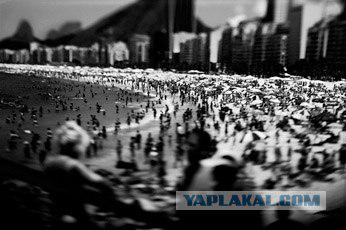
Repulse Bay (Hong Kong): garbage
The original Chinese name of this island in the south of the bay of Hong Kong means "place where gulls nest." However, birds have long left this bay: the trash and all kinds of dirt - the typical problems of urban beaches - in Repulse Bay reached its climax.
Construction work, which began in the early XX century, cause enormous damage to the ecology of the entire region: the production of waste is discharged directly into the waters of the South China Sea. Water pollution gulf is so great that in some places it had seen "red tides", and epidemiological verification composition of the water showed that it contains a record number of chemical elements. All this has led to the growth of bacteria and algae breeding parasites that kill all marine life and also have persistent bad breath. Local residents and environmental organizations have sought to deal with industrial lawlessness: here periodically organize and strike action in defense of the ecology of the region. But the authorities prefer the convenience of citizens the economic benefit: property near Repulse Bay is one of the most elite and expensive all over Hong Kong.
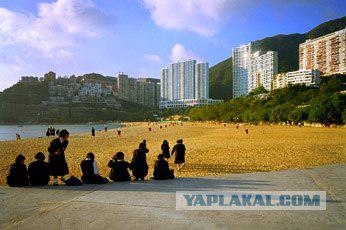
The beaches of São Paulo (Brazil): piranha
Since the days of Theodore Roosevelt's famous trip to the Amazon, when he saw the victims of carnivorous piranhas become large animals and heard stories about eaten alive by natives, the attitude has changed to the piranhas. River Predators still pose a danger to humans.
They are most active in the south-eastern tributaries of the Amazon River in Brazil. So, in 2002 on the beach Conceicao in Santa Cruz for five weekends victims of the "river of hyenas" were 38 swimmers. Two outbreaks of aggression fish were recorded in 2003 on the beach in Itapuã and Iacanga: there for 2 weeks from piranhas have suffered more than 50 people. According to the latest data also show that the greatest concern is the beaches of the city of Sao Paulo, where in December 2009, 74 people bitten by piranhas. Although official reports of deaths have been reported, there were numerous cases of amputation of fingers a rest.
Environmentalists explain the outbreak of aggression in the river predators interference in their habitat zone: construction of river embankments creates the conditions for an uncontrolled multiplication of piranhas and, consequently, the emergence of "nests" where it should be - in the public swimming areas.
Piranhas reach up to 30 cm in length, capable of easily grown piranha bite in half a human finger. It should, however, remember that not all carnivorous piranhas: some can only eat the plants, seeds or algae. So many horror movies dedicated to the bloodthirsty and ruthless predators river, in many respects, according to biologists, banal exaggeration.
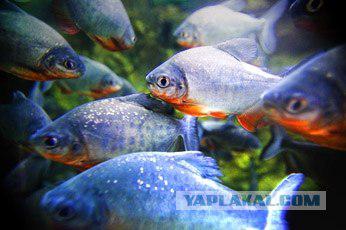
Beaches Virginia Beach (USA): the attack of wild foxes
Virginia Beach even mentioned in the Guinness Book of Records: it is a city with the longest public beach on the Atlantic coast and the Chesapeake Bay. In addition, it is also considered one of the cleanest and most affluent resort towns of America.
However, parks and beaches of Virginia Beach are attractive not only for tourists but also for wild animals. Rabid fox attacks on the people involved here in June 2010 and in March 2011, the fox attacked three visitors to the beach, causing them a few bites and scratches.
The attacks of wild animals in Virginia Beach generally quite frequent: in addition to the wild foxes in autumn 2006. The Magazine of Virginia Beach is also reported that in the forest belt near the beach garbage cans were seen wild raccoons and squirrels - potential
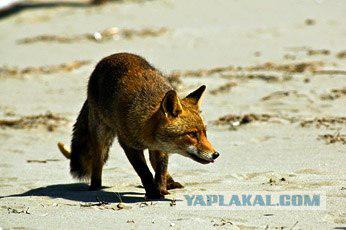
Cable Beach (Australia): crocodiles
Not so long ago attracted the attention of biologists, 22-kilometer-long beach of Cable Beach in Broome, Australia. It was there that were witnessed by the appearance of multiple horrific size reptiles, and most recently - on Monday, July 25 - the beach has once again been officially closed.
As a species, crocodiles are protected under Australian law, and hunting them is banned since 1974. That is, as the experts, and is the cause of frequent attacks by predators on the people. In 2009, after a series of attacks, including the children, there was a dispute about the partial lifting of the ban on catching reptiles (at least 25 representatives per year). However, the Australian authorities have not given the consent, for fear that such measures will attract tourists who are dreaming to get the jaws of a crocodile as a hunting trophy.
Usually attacks crocodile in Australia occur on the beaches of the Northern Territory - to popular resorts such as Queensland and around the city of Darwin. Over the past 25 years, there were more than 10 deaths predation on humans.
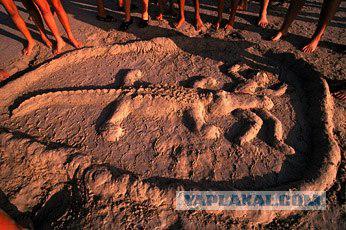
Source:
It is believed that Australian beaches - the most dangerous in the world. In addition to shark attacks, which are common in Australia, almost every year in the resorts of the northern coast, vacationers are victims of jellyfish. They are known to have one of the most potent venoms, and burns caused by their stinging cells can lead to death within minutes. In addition, these jellyfish rather inconspicuous and see them in the water is not easy.
Collision with them most likely in the waters of the Timor and Arafura seas surrounding the islands Tiwi Beach and north-east coast of Queensland. "Sea Wasp" - as they are sometimes called - even become a kind of symbol of the resort: the 2011 edition in Australia, even released a silver coin with the image of the beast.
However, death from encounters with jellyfish still quite rare. The most vulnerable of the victims - the children: they often do not survive his injuries. So, of the 30 reported cases of attacks on the northern coast of Australia over the past 20 years, 12 of them resulted in infant death. However, last year it was miraculously saved 10-year-old girl who was admitted to the hospital with multiple burns.
To reduce the risk, experts advise to refrain from swimming on the northern coast of Australia from October to April, especially in the afternoon when the jellyfish are most active.
Source

Beaches Fish Hoek (South Africa): white shark
The coast of Cape Town has repeatedly recognized the most dangerous place in the world for tourism in the Atlantic waters surrounding the coast of the province of the Western Cape, home to one of the world's largest populations of white sharks that with the onset of heat are particularly aggressive.
And despite the fact that the majority of the most popular beaches in the South African resort of Fish Hook back in the 1960s were undersea networks, avoid predators attacks still can not. For example, in 2010 there were registered 21 unprovoked shark attack, six of which resulted in death. The last case of shark attack on a person within the coastline was in January of last year and was particularly brutal: the body torn by the police catch the men throughout the following month.
Those who do not want to repeat the fate of the unfortunate can follow the activity of white sharks in the Shark Spotters organization's website in the section «shark activity»: last appearance of white predator there were registered on 21 June.

Zipolite Beach (Mexico): a strong undercurrent
Quiet and small beach with silky white sand and turquoise waters of the Pacific Ocean attracts many tourists. However, the locals prefer to avoid this place - especially during the period from April to June, when the water is here to say, "rebels».
This revolt is expressed strong undercurrents, including the reverse, which is difficult to see from the shore. In addition, in the summer months during the full moon usually occurs ebb and flow of the high seas, with the force of the flow are difficult to handle even an adult. The danger increases and by sea cliffs and rocks that lurk in the depths of the ocean.
Each year, the Mexican authorities to spend a decent amount on the organization of work of the rescuers, and indeed since 2007 on the beach was not a single fatal case (although in 2010 it was officially rescued 180 people who have failed the course, ignoring the set on the shores of the red flags) .
By the way, the name of the beach and the bay - Zipolite - a very disturbing in itself: translated from the local dialect of Zapotec means "Beach of the Dead". Nevertheless, the beach is known as one of the main objectives of the summer nudists and hippies from all over the world: there are inexpensive holiday and picturesque place.

Bikini Atoll (Marshall Islands): high levels of radiation
This small atoll in the Pacific Ocean is famous not only because it gave the name of a bathing suit, a spectacular appearance in which the famous Brigitte Bardot in the film "And God Created Woman." In the period from 1946 to 1958, the first United States used the island for testing atomic and hydrogen bombs in Operation "Crossroads." During the tests, March 1, 1954 the island was destroyed almost completely. Subsequently, more than 800 residents of the Pacific atoll died from various cancers caused by the nuclear tests.
Radiation levels are still above the norm: the average external dose of about 3, 8 R / h. Nevertheless, many believe that some beaches are quite suitable for bikini holiday: tourists from all over the world attracted by the isolation of the "nuclear" of the island. However, to get on the atoll is not so easy, either as part of the Central Pacific Expedition diving, or as tourists on a tour on the official website bikini. Seven-day trips usually take place from mid-April to November, in groups of 12-15 people.

Beach New Smyrna (USA): shark, accidents, lightning strikes
One of the main beaches of Florida rightly gained fame very unhappy resort staff. In 2010, there were recorded 640 collisions various swimming facilities, 68 of which resulted in death - the highest number of accidents on the water ever recorded on the beaches of the US. Experts attribute this to strong overcrowded beach: rescuers and Water Patrol simply no way to keep track of everything.
In addition, New Smyrna is also dangerous because of frequent lightning. Over the past 50 years from a lightning strike killed 459 people here. According to security officials, the people on the beach are the highest points, which means that during thunderstorms priori they become targets for discharges.
In addition to all of the above, and regardless of the weather, holidaymakers on the beach New Smyrna - target sharks. Last summer, 13 people were bitten and, fortunately, only 1 case proved fatal. It is not surprising that the evacuation of people, followed by multi-day closures on this beach - is quite common.

Beach Copacabana (Brazil): a high crime rate
Former mid-1950s playground for recreation of high society, today the Copacabana Beach in Rio de Janeiro has a reputation as the most troubled places to relax: the crime rate there - one of the highest in the whole of Brazil. Robbery, prostitution, drug trafficking, rape and even kidnapping - everyday phenomenon for this place. In 2010, victims of crimes of varying severity it began more than 80 people, while 30 people were killed.
For the Government of Brazil, the region - one of the most problematic: it is in the region of Copacabana, according to police, the largest number of drug lords and members of the mafia. Vacationers also say that danger awaits travelers not only on the Copacabana beach, but also in hotels on the coast, too, is not always easy. And for those who decide to take, for example, rent a yacht, it is worth remembering that in the water area of Copacabana is not uncommon for pirate hijackings. Read more about it here.

Repulse Bay (Hong Kong): garbage
The original Chinese name of this island in the south of the bay of Hong Kong means "place where gulls nest." However, birds have long left this bay: the trash and all kinds of dirt - the typical problems of urban beaches - in Repulse Bay reached its climax.
Construction work, which began in the early XX century, cause enormous damage to the ecology of the entire region: the production of waste is discharged directly into the waters of the South China Sea. Water pollution gulf is so great that in some places it had seen "red tides", and epidemiological verification composition of the water showed that it contains a record number of chemical elements. All this has led to the growth of bacteria and algae breeding parasites that kill all marine life and also have persistent bad breath. Local residents and environmental organizations have sought to deal with industrial lawlessness: here periodically organize and strike action in defense of the ecology of the region. But the authorities prefer the convenience of citizens the economic benefit: property near Repulse Bay is one of the most elite and expensive all over Hong Kong.

The beaches of São Paulo (Brazil): piranha
Since the days of Theodore Roosevelt's famous trip to the Amazon, when he saw the victims of carnivorous piranhas become large animals and heard stories about eaten alive by natives, the attitude has changed to the piranhas. River Predators still pose a danger to humans.
They are most active in the south-eastern tributaries of the Amazon River in Brazil. So, in 2002 on the beach Conceicao in Santa Cruz for five weekends victims of the "river of hyenas" were 38 swimmers. Two outbreaks of aggression fish were recorded in 2003 on the beach in Itapuã and Iacanga: there for 2 weeks from piranhas have suffered more than 50 people. According to the latest data also show that the greatest concern is the beaches of the city of Sao Paulo, where in December 2009, 74 people bitten by piranhas. Although official reports of deaths have been reported, there were numerous cases of amputation of fingers a rest.
Environmentalists explain the outbreak of aggression in the river predators interference in their habitat zone: construction of river embankments creates the conditions for an uncontrolled multiplication of piranhas and, consequently, the emergence of "nests" where it should be - in the public swimming areas.
Piranhas reach up to 30 cm in length, capable of easily grown piranha bite in half a human finger. It should, however, remember that not all carnivorous piranhas: some can only eat the plants, seeds or algae. So many horror movies dedicated to the bloodthirsty and ruthless predators river, in many respects, according to biologists, banal exaggeration.

Beaches Virginia Beach (USA): the attack of wild foxes
Virginia Beach even mentioned in the Guinness Book of Records: it is a city with the longest public beach on the Atlantic coast and the Chesapeake Bay. In addition, it is also considered one of the cleanest and most affluent resort towns of America.
However, parks and beaches of Virginia Beach are attractive not only for tourists but also for wild animals. Rabid fox attacks on the people involved here in June 2010 and in March 2011, the fox attacked three visitors to the beach, causing them a few bites and scratches.
The attacks of wild animals in Virginia Beach generally quite frequent: in addition to the wild foxes in autumn 2006. The Magazine of Virginia Beach is also reported that in the forest belt near the beach garbage cans were seen wild raccoons and squirrels - potential

Cable Beach (Australia): crocodiles
Not so long ago attracted the attention of biologists, 22-kilometer-long beach of Cable Beach in Broome, Australia. It was there that were witnessed by the appearance of multiple horrific size reptiles, and most recently - on Monday, July 25 - the beach has once again been officially closed.
As a species, crocodiles are protected under Australian law, and hunting them is banned since 1974. That is, as the experts, and is the cause of frequent attacks by predators on the people. In 2009, after a series of attacks, including the children, there was a dispute about the partial lifting of the ban on catching reptiles (at least 25 representatives per year). However, the Australian authorities have not given the consent, for fear that such measures will attract tourists who are dreaming to get the jaws of a crocodile as a hunting trophy.
Usually attacks crocodile in Australia occur on the beaches of the Northern Territory - to popular resorts such as Queensland and around the city of Darwin. Over the past 25 years, there were more than 10 deaths predation on humans.

Source:
Tags
See also
The most dangerous bridge in the world
Scientists have discovered a new most dangerous substance in the world
The three most dangerous active volcanoes in the world
The most dangerous migration
World's fastest electric car presented in Shanghai
The highest hotel in the world
Allure of the Seas - world's largest cruise ship
The world's largest tent Khan Tent
The world's longest art gallery
The world's largest flower Park

















